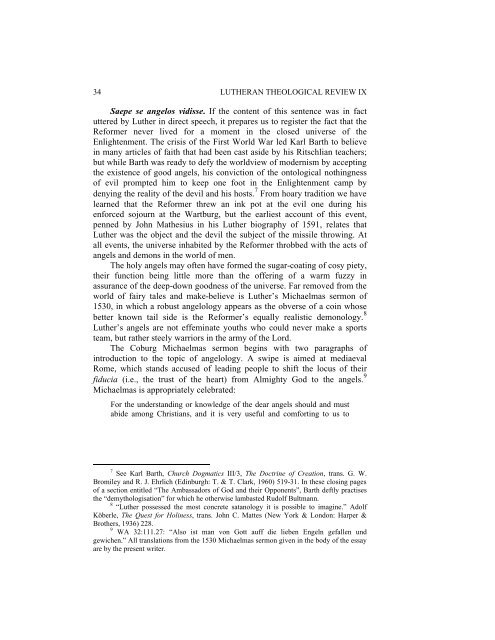LUTHERAN THEOLOGICAL REVIEW - Brock University
LUTHERAN THEOLOGICAL REVIEW - Brock University
LUTHERAN THEOLOGICAL REVIEW - Brock University
Create successful ePaper yourself
Turn your PDF publications into a flip-book with our unique Google optimized e-Paper software.
34 <strong>LUTHERAN</strong> <strong>THEOLOGICAL</strong> <strong>REVIEW</strong> IX<br />
Saepe se angelos vidisse. If the content of this sentence was in fact<br />
uttered by Luther in direct speech, it prepares us to register the fact that the<br />
Reformer never lived for a moment in the closed universe of the<br />
Enlightenment. The crisis of the First World War led Karl Barth to believe<br />
in many articles of faith that had been cast aside by his Ritschlian teachers;<br />
but while Barth was ready to defy the worldview of modernism by accepting<br />
the existence of good angels, his conviction of the ontological nothingness<br />
of evil prompted him to keep one foot in the Enlightenment camp by<br />
denying the reality of the devil and his hosts. 7 From hoary tradition we have<br />
learned that the Reformer threw an ink pot at the evil one during his<br />
enforced sojourn at the Wartburg, but the earliest account of this event,<br />
penned by John Mathesius in his Luther biography of 1591, relates that<br />
Luther was the object and the devil the subject of the missile throwing. At<br />
all events, the universe inhabited by the Reformer throbbed with the acts of<br />
angels and demons in the world of men.<br />
The holy angels may often have formed the sugar-coating of cosy piety,<br />
their function being little more than the offering of a warm fuzzy in<br />
assurance of the deep-down goodness of the universe. Far removed from the<br />
world of fairy tales and make-believe is Luther’s Michaelmas sermon of<br />
1530, in which a robust angelology appears as the obverse of a coin whose<br />
better known tail side is the Reformer’s equally realistic demonology. 8<br />
Luther’s angels are not effeminate youths who could never make a sports<br />
team, but rather steely warriors in the army of the Lord.<br />
The Coburg Michaelmas sermon begins with two paragraphs of<br />
introduction to the topic of angelology. A swipe is aimed at mediaeval<br />
Rome, which stands accused of leading people to shift the locus of their<br />
fiducia (i.e., the trust of the heart) from Almighty God to the angels. 9<br />
Michaelmas is appropriately celebrated:<br />
For the understanding or knowledge of the dear angels should and must<br />
abide among Christians, and it is very useful and comforting to us to<br />
7 See Karl Barth, Church Dogmatics III/3, The Doctrine of Creation, trans. G. W.<br />
Bromiley and R. J. Ehrlich (Edinburgh: T. & T. Clark, 1960) 519-31. In these closing pages<br />
of a section entitled “The Ambassadors of God and their Opponents”, Barth deftly practises<br />
the “demythologisation” for which he otherwise lambasted Rudolf Bultmann.<br />
8 “Luther possessed the most concrete satanology it is possible to imagine.” Adolf<br />
Köberle, The Quest for Holiness, trans. John C. Mattes (New York & London: Harper &<br />
Brothers, 1936) 228.<br />
9 WA 32:111.27: “Also ist man von Gott auff die lieben Engeln gefallen und<br />
gewichen.” All translations from the 1530 Michaelmas sermon given in the body of the essay<br />
are by the present writer.













